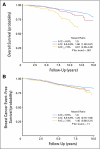Clinically defined type 2 diabetes mellitus and prognosis in early-stage breast cancer
- PMID: 21115861
- PMCID: PMC3055860
- DOI: 10.1200/JCO.2010.29.3183
Clinically defined type 2 diabetes mellitus and prognosis in early-stage breast cancer
Abstract
Purpose: Self-reported diabetes has been associated with poor breast cancer outcomes. Research is needed to investigate the relationship between biologically determined glycemic control and breast cancer prognosis.
Methods: Archived baseline blood samples from the Women's Healthy Eating and Living Study were used to measure hemoglobin A1C (HbA1C) among 3,003 survivors of early-stage breast cancer (age of diagnosis, 28 to 70 years) observed for a median of 7.3 years for additional breast cancer events and 10.3 years for all-cause mortality. HbA1C levels provide an accurate, precise measure of chronic glycemic levels. Cox regression analysis was performed to assess whether baseline HbA1C levels predicted disease-free and overall survival.
Results: Only 5.8% of women had chronic hyperglycemia (defined as HbA1C levels ≥ 6.5%). Those with HbA1C ≥ 6.5% were older and more likely to be less educated, have nonwhite ethnicity, be obese, and have more advanced breast cancer at diagnosis. HbA1C was significantly associated with overall survival (P(trend) < .001). After adjusting for confounders, risk of all-cause mortality was twice as high in women with HbA1C ≥ 7.0% compared with women with HbA1C less than 6.5% (hazard ratio [HR], 2.35; 95% CI, 1.56 to 3.54). For disease-free survival, there was a nonsignificant 30% increase in risk for HbA1C levels ≥ 7.0% (HR, 1.26; 95% CI, 0.78 to 2.02). During study follow-up, previously diagnosed rather than undiagnosed diabetes seemed to account for the increased risk.
Conclusion: Chronic hyperglycemia is statistically significantly associated with reduced overall survival in survivors of early-stage breast cancer. Further study of diabetes and its relationship to breast cancer outcomes is warranted.
Conflict of interest statement
Authors' disclosures of potential conflicts of interest and author contributions are found at the end of this article.
Figures


Comment in
-
Insulin breast cancer connection: confirmatory data set the stage for better care.J Clin Oncol. 2011 Jan 1;29(1):7-10. doi: 10.1200/JCO.2010.32.3022. Epub 2010 Nov 29. J Clin Oncol. 2011. PMID: 21115871 No abstract available.
References
-
- Yancik R, Wesley MN, Ries LA, et al. Effect of age and comorbidity in postmenopausal breast cancer patients aged 55 years and older. JAMA. 2001;285:885–892. - PubMed
-
- Tammemagi CM, Nerenz D, Neslund-Dudas C, et al. Comorbidity and survival disparities among black and white patients with breast cancer. JAMA. 2005;294:1765–1772. - PubMed
-
- Harris MI, Klein R, Welborn TA, et al. Onset of NIDDM occurs at least 4-7 yr before clinical diagnosis. Diabetes Care. 1992;15:815–819. - PubMed
Publication types
MeSH terms
Substances
Grants and funding
LinkOut - more resources
Full Text Sources
Medical

